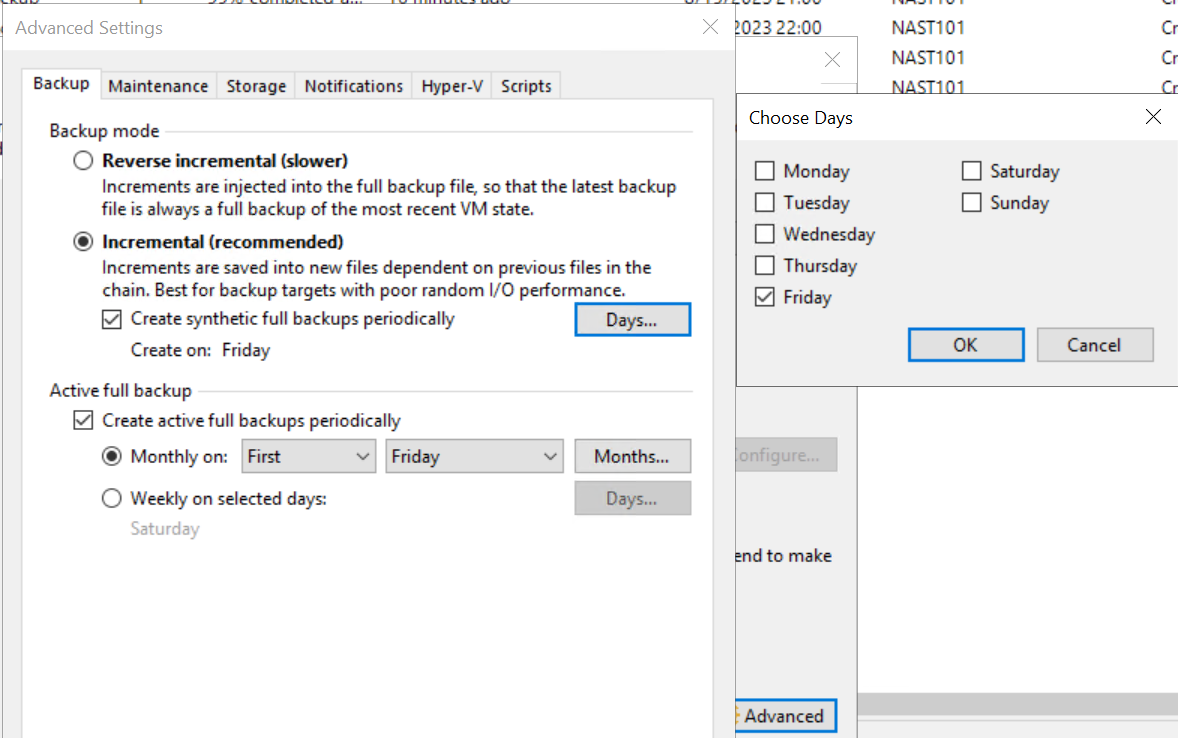Hello to all Backup solutions architects 😀,
I will need advice in configuration of our Backups so that I can achieve as close as possible to the 3-2-1-1-0 rule.
Our Current Backup Infrastructure is as follow:
1 x Synology RS3621xs+ in Vienna, Austria.
1 x Synology RS3621xs+ in Novi Sad, Serbia.
1 x Synology DiskStation DS1019+ in Novi Sad, Serbia.
I wanted to implement Wasabi to our Infrastructure but didn’t get the green light, it is not approved.
Current Backups are setup in the following:
1. All our critical infrastructure is being backed up to the NAS in Vienna with this configuration:
I had an topic where we discussed about not needing Synthetic Full Backups periodically and Active Full Backups both enabled for the job. Need more opinions on this since I’m not professional in Veeam.
I don’t see a need for both active and synthetic. If you’re using a REFS or XFS volume, synthetic fulls should be find due to link block cloning. If using a different filesystem, you can still use synthetic but know that running synthetic fulls does create a lot of IO and on a NAS, that may not be desired for performance reasons. Using Active fulls may be preferred because then it’s pretty much just sequential write operations, but know that you’ll be reading the data from the source VM’s so you’ll create more load on your primary storage. You’ll have to weigh which is better. Either way, I probably wouldn’t do both.
I was doing research and saw that 3-2-1-1-0 rule is the way to go.
What could I do with our current Infrastructure to optimize our backups as best as possible?
Is there an option to create Imutable backups to our smallest NAS with only Veeam software or with some Linux based tools since Synology is based on the Linux.
I would also like to implement SureBackup to achive the 0 errors.
I’m not going to suggest this as a recommendations, but technically…you can run a docker container (I think) or linux VM (I know) on the NAS itself and present a volume to the VM to be utilized as a Hardened Linux Repository. I don’t know what performance will be like exactly (I have one client doing this and it works, but they only have a couple of VM’s utilizing this configuration in a copy job), and I’m not sure what a failure would look like exactly, but it can be done.
The better suggestion would be to utilize a physical server (or even workstation) running a Linux distro and connecting to the NAS via ISCSI and utilizing as a hardened repo.
Finally, one other thing I would look into, but haven’t tried (it was on my list before Veeam released the LHR capability) was to try using the object lock capabilities in MINIO. This can give you object storage capabilities where you should again be able to utilize immutability.
Hello @dloseke,
Thank you for this intense comment that you did. It clear my mind a little bit.
Currently I’m testing using Synology iSCSI LUN that is connected to our VBR at the moment and its formated as ReFS (64KB).
I’m waiting for synthetical full to be created so that I can see the difference between ReFS and iSCSI over SMB Share on the NAS itself.
For the Immutability I will check your options and see what I can do. Didn’t have that much hand’s on experience with Linux except setting few basic things but now I can have a small/fun project to play and learn.
Thank you for this,
I appreciate it :)
Hello @dloseke,
Thank you for this intense comment that you did. It clear my mind a little bit.
Currently I’m testing using Synology iSCSI LUN that is connected to our VBR at the moment and its formated as ReFS (64KB).
I’m waiting for synthetical full to be created so that I can see the difference between ReFS and iSCSI over SMB Share on the NAS itself.
For the Immutability I will check your options and see what I can do. Didn’t have that much hand’s on experience with Linux except setting few basic things but now I can have a small/fun project to play and learn.
Thank you for this,
I appreciate it :)
I’m in the same boat for Linux...I’ve used it here and there over the years, but am by no means any sort of expert. That said, there’s an ISO I believe now generally available for deploying the LHR’s that make things a lot easier. I’m about to try it shortly for an internal server.

